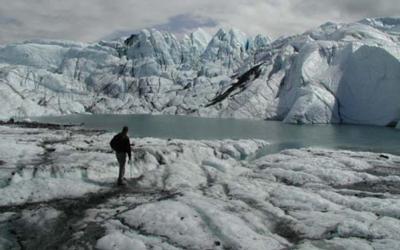6 July, 2000
July 6, 2000
Matanuska Glacier, Alaska
As the past few days have unfolded Iíve begun to get a better idea of
whatís going on at this camp. Coming in I only knew that there would
initially be some students here working on their masters research
projects or related works. And yet from what I observed I was a bit
confused as to how some of the tasks that were being performed related
to their work. Yesterday I found that part of their duties here are to
collect data for the Cold Regions Research and Engineering Lab (CRREL).
A message had come in to deploy more ISCOís in strategic locations. It
turns out that quite a bit of the daily routine that Justin Pierce, Ben
Cashman and Josh Lawson perform is centered around gathering this data.
In addition to downloading electronic data there are also water samples
that are filtered, dried and weighed before going into storage for
possible future use in sediment discharge analysis.
After helping to set up more ISCO stations in the morning Ben Burnette
and I were taken out onto the glacier by Ben Cashman to look for
moulins. Moulins are basically holes in the glacier that the surface
meltwater drains into, much like streets drain into sewer systems. The
sun and rising temperatures of summer cause the surface ice to melt at
an ever increasing rate and the ice becomes quite slick when wet. I
bought a pair of ice crampons in Anchorage the other day before heading
out to the glacier. Crampons are devices that strap onto the soles of
hiking boots and allow a person to maintain good footing on ice.
Projecting out from the bottom of the crampons are somewhat sharp points
of steel that penetrate just slightly into the ice to provide secure
traction. After getting a few very good instructions from Ben C. about
some of the finer points of walking on ice with crampons we headed out
across the glacier. I realized very quickly how much these things help
as we scrambled up what would otherwise have been a challenging slope in
ordinary hiking boots. And it didnít take too long to realize that it
would be very easy to turn an ankle if you didnít concentrate on where
you were placing your feet at times. On ice that was not relatively
smooth I found myself trying to step on small mounds as opposed to small
dips. Now this is quite opposite from what I would normally do in hiking
boots on a slick surface, be it mud or ice. In slick situations I always
looked to avoid the high spots for fear of the foot slipping off.
Rather, the low depressions seemed the safest spot to place a foot. But
I noticed early on that if I stepped in narrow depressions on ice that
certain spikes dig in first and dictate what the rest of the foot will
do. And so it would be very easy to sprain an ankle if I were to place a
foot off-center in a depression. One side of the foot would grip on the
high side first and the rest would turn and quickly plant on the low
side. Most of the time this was not a problem.
We walked over a variety of slopes and ice in order to get accustomed to
this new experience. Eventually we arrived at a very pretty and
interesting glacial lake. The walls on the far side contained many
different shades of blue and the water draining into and out of this
lake produced some spectacular shapes. After a short break here we
headed off to find the moulins that Ben C. had found last week. As I
said before, moulins are holes in the glacier into which surface
meltwater will drain. The first one we came to was quite large and a
good flow of water was rushing in. The ice sloped gradually into the
moulin in some places and yet was quite steep in others. I felt very
safe walking around looking into the depths of this hole. It was quite
deep and we could not even see the bottom from the best viewing angle.
Without crampons this parcticular moulin would have to be viewed from a
much greater distance. We saw several other moulins on our way, each one
unique and interesting in its own way, but much smaller than the first
one. Once we were back on relatively flat ice we removed the crampons.
Ben C. warned us to be careful walking now without the crampons. It was
a little strange to walk on this ice now and getting the sensation that
it was quite slick. We had crossed this same ice earlier without the
crampons and it just didnít seem so slick the first time. After a short
time we were used to it and walking normally once again. Along the way
Ben B. and I discussed some possible strategies for starting our project
which we hope to begin tomorrow. Till then.....
Marvin Giesting

Ben Cashman and Ben Burnette walk carefully with ice crampons around a moulin. This was the first and the largest moulin we saw today.

Ben Cashman pauses to admire the glacial lake during our hike.
Contact the TEA in the field at
.
If you cannot connect through your browser, copy the
TEA's e-mail address in the "To:" line of
your favorite e-mail package.
|
